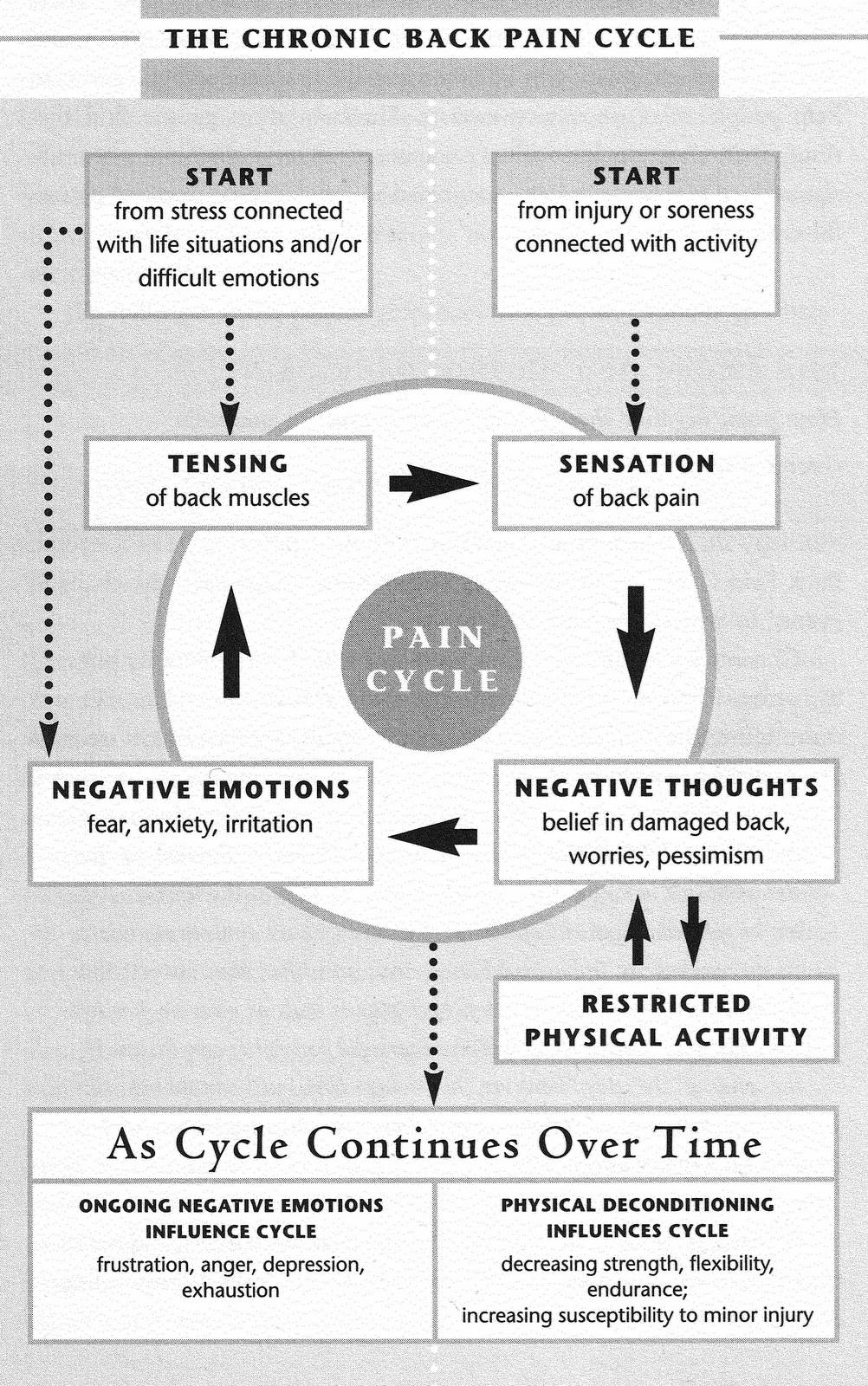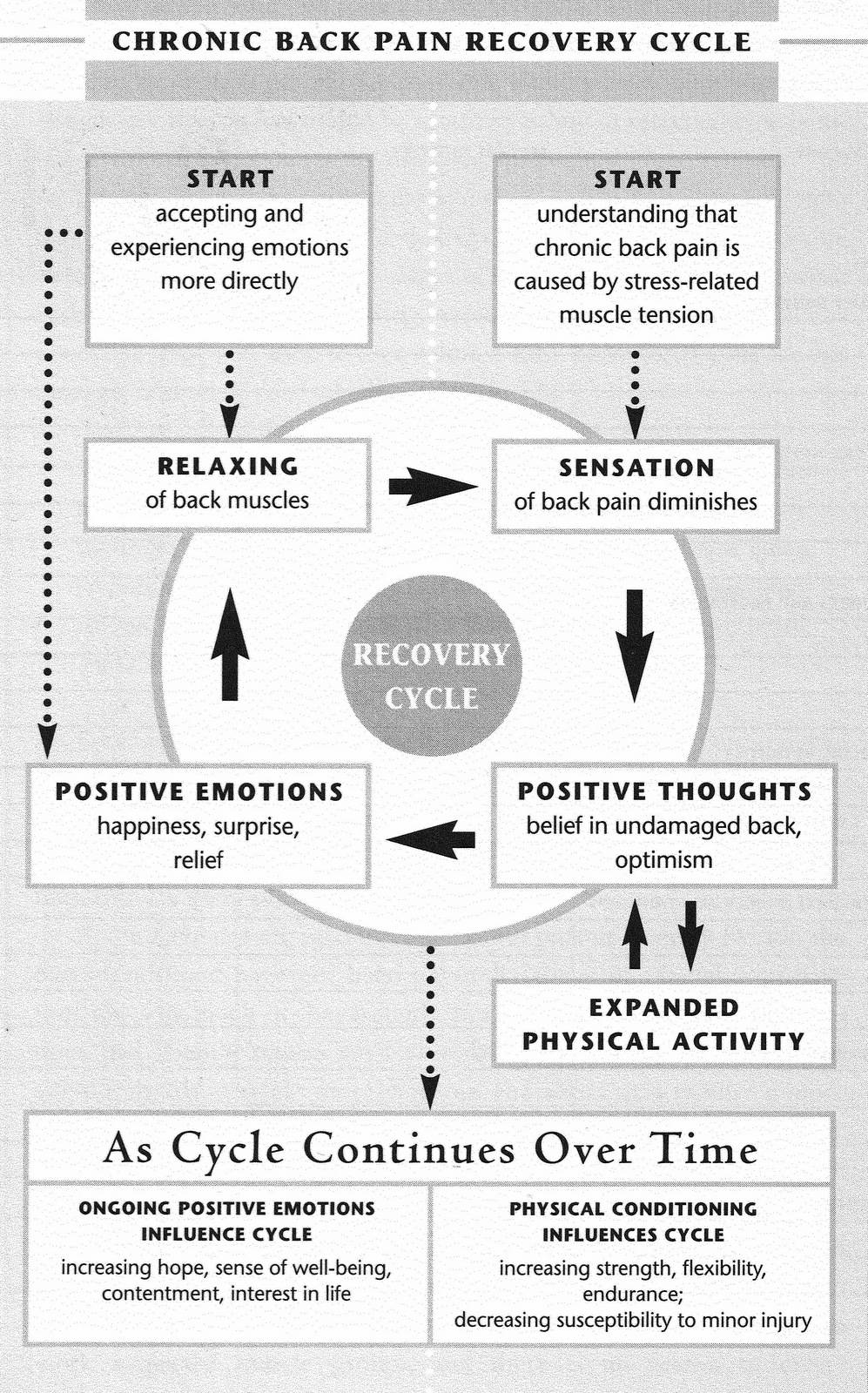Is Back Sense Right for Me?
The Back Sense program is suitable for almost anyone suffering from pain in the back or neck, as well as related pain that is felt in the legs or arms, which has lasted for more than a couple of months. While we use the term “back” throughout the book, the treatment principles we outline apply equally well to most neck pain. We say “almost anyone” because there are a very small number of chronic back pain cases that are caused by some kind of underlying medical problem that requires special attention. This is an exception to the rule that affects only about one in two hundred people.
Healthcare professionals make a distinction between acute and chronic back pain. Usually acute back pain means pain lasting less than two or three months, while chronic means lasting longer. It is something of an oversimplification, but acute back pain may be primarily a bodily problem, whereas chronic back pain involves mind as much as body. Often, acute back pain is caused by common injuries such as muscle strains. These usually heal on their own in a month or two. While the principles we describe can help prevent acute back pain from turning into chronic back pain, they are designed especially for people whose pain has persisted. If your pain has lasted for at least two months and doesn’t seem to be getting better, you are probably getting caught in the chronic back pain syndrome caused by muscle tension.
Before You Begin
It is essential to get a good medical evaluation by a qualified physician before starting the Back Sense program or adopting the methods that we advocate.
This program is not intended to provide specific, individual medical advice or treatment and should not take the place of medical advice from a trained professional. Users are strongly urged to consult a physician or other qualified professional person regarding any diagnosis or treatment of medical conditions. While we have taken great care to make sure all of our statements regarding back pain are based on high quality research, the authors can not take any responsibility for any possible consequences from any treatment, action or application of medicine, to any person using the information in this site. The information in this site is intended to be general and applied in the context of someone working with a physician or other health professional in the treatment of their condition.
If you are having difficulty finding a physician who will help you take a very active physical approach to your back pain, we recommend finding a physiatrist in your area (a physician specializing in physical medicine and rehabilitation). They have special training in muscle problems and are likely to recommend exercise. You can get a referral from your primary health care provider or contact the American Academy of Physical Medicine and Rehabilitation at www.aapmr.org.
The Chronic Back Pain Cycle

The Chronic Back Pain Cycle describes how the mind and body work together to cause chronic back pain. The cycle may begin with a muscle strain from over exertion or an accident. If the pain from this starts to interfere with our life, we are likely to become anxious or upset about it. Research has shown that this emotional distress actually tightens our back muscles, which further increases our pain.
Soon a vicious cycle gets going in which our pain causes emotional stress, which increases the tension in our back muscles. This in turn causes more pain, which causes more emotional stress, and yet more pain. Along the way, we usually become afraid to use our back normally, which causes our muscles to become tighter and weaker. This cycle can last for days, weeks, and even years. It usually persists long after the original injury has healed.
Sometimes the cycle seems to begin “out of the blue,” without any clear injury. In these cases, stress in our life has usually caused our muscles to become short, tight, and vulnerable to spasms. No matter how it starts, the Chronic Back Pain Cycle can soon take on a life of its own.
In Back Sense we help you to see how your own Chronic Back Pain Cycle works, and help you to interrupt it by following a step by step program.
The Chronic Back Pain Recovery Cycle

The Chronic Back Pain Recovery Cycle describes how the mind and body can work together to free a person from chronic back pain. The solution begins by understanding that most chronic back pain actually isn’t caused by damage to the structures of the back, but rather is due to the effects of muscle tension, stress, and inactivity. After receiving a medical evaluation, and learning why it is safe to resume normal activity, the fear and distress that accompanies chronic back pain begins to diminish.
Feeling some confidence, it is now possible to increase physical activity, step by step. Once you see for yourself that this does not, in the long run, significantly increase your pain, you are well on the way to recovery. You begin to relax further, move more normally, and develop the confidence needed to resume more and more activities. This leads to improved mood, less tension, and less pain.
If along the way, you discover that there are other important sources of emotional stress in your life, the Back Sense program offers ways to work constructively with these so that they don’t continue to contribute to the pain.
Eventually, after regaining all normal activities and developing strength, flexibility, and endurance; you can live a normal life and no longer think of yourself as someone with a “bad back.”
Back Sense Research
We recognize that delivering so much good news about what has often been considered to be an intractable medical problem may strain credibility. Common sense suggests that chronic back pain must be caused by serious injuries or abnormalities, requiring medical interventions and/or time to heal. Furthermore, contradicting prevailing medical practice quite naturally raises suspicions of quackery. By all means remain skeptical, but consider the rather astonishing findings of some recent highly regarded scientific studies:
- The New England Journal of Medicine reports that most healthy people, who have never experienced back pain at all, have the very same displaced disks and other spinal abnormalities that have traditionally been blamed for chronic back pain.
- After spinal abnormalities are surgically repaired, many back pain patients continue to report their original symptoms. At the same time, the backs of other patients with identical symptoms appear completely normal when viewed with CT scans and MRI’s.
- The Journal of the American Medical Association reports that back surgeries conducted in the past, before we had CT scans and MRI’s, often found nothing out of place. Surgeons simply sewed patients up again because there was nothing to repair. These so-called “negative surgical explorations” cured patients’ symptoms more than 40% of the time.
- The New England Journal of Medicine reports that “Back School” programs that teach patients how to sit, lift, bend, and walk properly, do not help to prevent chronic back pain.
- The New England Journal of Medicine also reports a study from Finland, where workers with back pain recovered most quickly when they simply went on with normal activities, and made no special efforts to heal their backs whatsoever. In fact, bed rest and caution actually interfered with recovery.
- A major study at the Boeing aircraft company found that job stress was the very best predictor of which employees would develop disabling back pain over a four-year period. Emotional stress was more significant than whether they did heavy lifting, sat for long hours, or were in poor physical condition.
- A study by psychologists at Yale University, and in Germany, found that the back muscles of back pain patients tense when they are exposed to emotional stress, while the muscles of back pain free individuals do not.
- A comprehensive review of studies published in the respected medical journal Spine, shows that poor, rural farmers whose backs undergo great physical stress have the lowest incidence of chronic back pain in the world.
Taken together, these studies and many others like them have led to the rapidly developing scientific view of which we have spoken—that most chronic back pain is caused by stress and muscle deconditioning, rather than by defective spinal structures. This realization leads to a very different way of helping patients to get better.
Download Charts and Exercises from Back Sense
Readers have asked for online copies of the charts and exercises in the Back Sense program to complete during their rehabilitation. You can download them here in pdf format:
